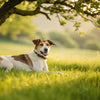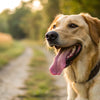How Long After Eating Can a Dog Exercise? Understanding Timing for Optimal Health
- Houndsy
Table of Contents
- Introduction
- Understanding Canine Digestion
- The Risks of Exercising After Eating
- Recommended Waiting Times
- Balancing Exercise and Nutrition
- Tips for Safe Exercise After Eating
- The Role of the Houndsy Kibble Dispenser
- FAQs
- Conclusion
Introduction
As dog owners, we often find ourselves navigating a myriad of questions about our furry friends' health and well-being. One such question that frequently arises is, how long after eating can a dog exercise?
According to veterinarians, the timing of exercise relative to your dog's meals is crucial for their health. Studies suggest that allowing a proper interval between meals and physical activity can prevent serious health issues, including gastric dilatation-volvulus (GDV), commonly known as bloat. This condition can be life-threatening, especially in larger breeds.
In this blog post, we will explore the critical aspects of exercise after meals, including the risks involved, recommended waiting times, and how to balance your dog's nutritional needs with their exercise regimen. By the end, you will have a comprehensive understanding of how to manage your dog's feeding and exercise schedule for their optimal health.
We’ll also touch on how our flagship product, the Houndsy Kibble Dispenser, can enhance your dog’s feeding experience, ensuring that mealtime is as convenient and enjoyable as possible.
Understanding Canine Digestion
To grasp why timing matters, we first need to understand how dogs digest their food. The digestion process begins when food is ingested, chewed, and swallowed. It then moves to the stomach, where it is broken down further by acids and enzymes. This mixture slowly moves into the intestines, where nutrients are absorbed.
The entire process can take anywhere from 6 to 10 hours depending on several factors, including your dog’s breed, size, age, and the type of food they consume. For instance, wet food is generally digested faster than dry kibble. Understanding this timeline is essential for determining when it is safe to exercise your dog after eating.
Factors Influencing Digestion
- Breed and Size: Larger breeds are more susceptible to bloating and GDV due to their anatomy.
- Age: Puppies have faster metabolism rates compared to older dogs, which may affect how quickly they digest food.
- Diet: High-fiber diets can slow digestion, while protein-rich diets may speed it up.
The Risks of Exercising After Eating
One of the main reasons to avoid exercising your dog soon after eating is the risk of bloat, a condition where the stomach fills with gas and can twist, cutting off blood supply. It’s a serious health emergency that requires immediate veterinary attention.
Symptoms of Bloat
- Restlessness
- Swollen abdomen
- Excessive drooling
- Attempts to vomit without success
- Rapid breathing or panting
While all dogs can bloat, certain breeds like Great Danes, Doberman Pinschers, and Boxers are at a higher risk. Understanding these risks can help you make informed decisions about your dog’s exercise and feeding schedule.
Recommended Waiting Times
So, how long should you wait after your dog eats before engaging in exercise? Here’s a general guideline:
- 30 minutes after a small snack
- 1 hour after a small meal
- 2 to 3 hours after a large meal
These times allow your dog’s digestive system to begin processing the food, reducing the risk of bloat during physical activity.
Why Timing Matters
When a dog exercises immediately after eating, blood flow is redirected to the muscles, which can inhibit proper digestion and lead to discomfort. This is why it’s essential to allow your dog adequate time to rest after meals before engaging in vigorous activities.
Balancing Exercise and Nutrition
Finding the right balance between exercise and nutrition is vital for your dog’s overall health. Regular exercise is critical for maintaining a healthy weight and preventing behavioral problems, while proper nutrition fuels that activity.
Benefits of Post-Meal Walking
Despite the risks, a gentle walk after meals can aid digestion and help your dog establish a regular potty schedule. It’s essential to keep the intensity low—think of it as a leisurely stroll instead of a vigorous run.
Establishing a Routine
Creating a routine that integrates feeding and walking can also help you manage your dog’s needs more effectively. For instance, you might consider scheduling walks at specific times of the day, ensuring that they align with feeding schedules.
Tips for Safe Exercise After Eating
- Monitor Portion Sizes: Feeding smaller meals more frequently can help alleviate the risk of bloat.
- Encourage Calmness: After meals, encourage your dog to relax. Providing chew toys or creating a comfortable resting space can help.
- Be Observant: Keep an eye on how your dog behaves after eating. If they show signs of discomfort or lethargy, it may be best to adjust their feeding or exercise routine.
The Role of the Houndsy Kibble Dispenser
At Houndsy, we understand that feeding times are a crucial part of your dog’s day. Our Houndsy Kibble Dispenser not only simplifies the feeding process by delivering perfect portions but also ensures that meals are served at the right time. With features designed for convenience and style, it complements your home decor while making mealtime stress-free.
By investing in a high-quality feeding solution, you can ensure that your dog gets the nutrition they need without the hassle.
FAQs
How long should I wait to walk my dog after a meal?
As a general rule, wait at least two hours after a large meal, one hour after a small meal, and 30 minutes after a snack before engaging in exercise.
What are the signs of bloat in dogs?
Common signs include a swollen abdomen, restlessness, attempts to vomit without success, excessive drooling, and rapid breathing.
Should I feed my dog before or after a walk?
Feeding your dog after a walk can be beneficial, especially if you are concerned about bloat. However, if your dog is particularly energetic, a small snack before a walk may be appropriate, followed by a wait period before the next meal.
Can all dogs bloat?
While all dogs can experience bloat, certain breeds, especially deep-chested ones like Great Danes and Dobermans, are at a higher risk.
How can I prevent my dog from bloating?
To minimize the risk of bloat, feed smaller meals more frequently, avoid vigorous exercise immediately after meals, and monitor your dog's behavior closely.
Conclusion
In conclusion, understanding how long after eating a dog can exercise is essential for maintaining their health and well-being. By implementing proper timing between meals and physical activity, we can significantly reduce the risk of serious health issues like bloat.
As responsible pet owners, let’s prioritize our dogs' health by creating a balanced routine that includes safe feeding and exercise practices. Don’t forget to explore our Houndsy Kibble Dispenser for a streamlined and stylish feeding experience that complements your dog’s needs.
Now, let’s ensure that our furry friends enjoy their meals and exercise safely and happily!












